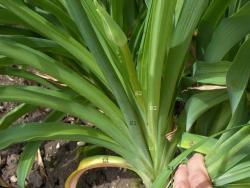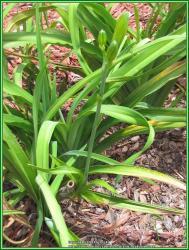Seedfork said:There is also instant re-bloom, some plants will send up one scape, then another and then another. I Don't know the "record or limit" for the number of scapes growing at one time on a single plant, but have heard of plants with three scapes showing at once.
Very surprisingly, because I am in zone 4, I have several cultivars or seedlings that are showing that this year. When I examined what the plants are doing it does not seem any different than the normal description of rebloom except that the new replacement fans grew so quickly that they produced their own scapes while the initial scape has not opened any flowers yet. In some cases there is only one replacement fan so there are two scapes inside the "one" fan (one scape produced by the original growing point and a second scape produced by the growing point of the replacement fan); in other cases there are two replacement fans but only one has produced a scape so there are two scapes inside the original fan but one of the scapes may look like it is outside of a fan (at least at first glance). And in a couple of plants there are two replacement fans and both have produced scapes so that there are three scapes inside "one" fan.
I will try to take pictures later although the plants are in clumps and it may not be easy to see the situations or I can diagram the situations (I think I may have done so previously and posted diagrams on ATP).
There are other situations where a fan may be able to produce two scapes without having produced a replacement fan but that would probably require that the growing point divide into two before producing scapes. That should look like L L L L L L S S R R R R R where L represents a lef facing leaf, S is a scape and R is a right facing leaf.
Typical bloom, one original fan - L L L L L S R R R R R - growth stopped once the scape was produced, no new leaves for some time.
Typical bloom, one original fan with one replacement fan - L1 L1 L1 L1 L1 L2 L2 L2 R2 R2 R2 S1 R1 R1 R1 R1 where L1 are left facing leaves from the original fan, L2 are left facing leaves of the replacement fan, S1 is the scape of the original fan, R2 are right facing leaves of the replacement fan and R1 are right facing leaves of the original fan.
Typical bloom one original fan with two replacement fans - L1 L1 L1 L2 L2 L2 R2 R2 R2 S1 L L L R R R R1 R1 R1 where L1 and R1 are leaves of the original fan, L2 and R2 are leaves of one of the replacement fans and L and R are leaves of the other replacement fan, S1 is a scape produced by the initial original fan (or growing point).
Now either one of the two replacement fans can produce a scape -
L1 L1 L1 L2 L2 L2 S2 R2 R2 R2 S1 L L L R R R R1 R1 R1 - the replacement fan on the left produced a scape so the whole compound fan has two scapes but is actually three fans and each scape was produced by a different fan or growing point.
L1 L1 L1 L2 L2 L2 R2 R2 R2 S1 L L L S R R R R1 R1 R1 - the replacement fan on the right produced the scape in this example. The whole compound fan has two scapes but each scape was produced by a different fan.
Or both replacement fans can produce scapes.
L1 L1 L1 L2 L2 L2 S2 R2 R2 R2 S1 L L L S R R R R1 R1 R1 The compound fan has three scapes but each was produced by one (different) fan or growing point.
Normal rebloom in which the initial scape stops blooming before a rebloom scape starts blooming (or starts tro grow and appears) happens when the replacement fans grow slowly enough. If they grow very quickly then the replacement fans can produce their own scapes before the initial fan finishes blooming or even sometimes before it starts blooming.
 In the photo L1 is one of the leaves of the original fan and R1 is one of the leaves of the original fan. Those leaves enclose the entire compound fan. S1 is the scape of the original fan. No buds have opened on it yet and it may be a couple of weeks yet before even the first bud opens on that initial scape. L2 and R2 are left and right leaves of the replacement fan that has grown to the right of the initial scape. S2 is the scape that belongs to the replacement fan. The replacement fan developed from an axillary bud found in the corner of the crown probably between the original scape and the last original leaf (an R1 category leaf) on the right of S1. It can be a little difficult to distinguish R2 from R1 category leaves but in this case (and perhaps usually) at least some of the older R1 leaves are shorter but wider than R2 leaves. It is usually easy to distinguish L2 from L1 leaves since the L2 category leaves will be to the right of the S1 scape (but left of the S2 scape). By counting the number of L2 leaves we get an estimate of approximately how many leaves to the right of the S2 scape are R2 leaves - the rest would be R1 leaves. That estimate is the same number of R2 leaves as there are L2 leaves say plus or minus one leaf.
In the photo L1 is one of the leaves of the original fan and R1 is one of the leaves of the original fan. Those leaves enclose the entire compound fan. S1 is the scape of the original fan. No buds have opened on it yet and it may be a couple of weeks yet before even the first bud opens on that initial scape. L2 and R2 are left and right leaves of the replacement fan that has grown to the right of the initial scape. S2 is the scape that belongs to the replacement fan. The replacement fan developed from an axillary bud found in the corner of the crown probably between the original scape and the last original leaf (an R1 category leaf) on the right of S1. It can be a little difficult to distinguish R2 from R1 category leaves but in this case (and perhaps usually) at least some of the older R1 leaves are shorter but wider than R2 leaves. It is usually easy to distinguish L2 from L1 leaves since the L2 category leaves will be to the right of the S1 scape (but left of the S2 scape). By counting the number of L2 leaves we get an estimate of approximately how many leaves to the right of the S2 scape are R2 leaves - the rest would be R1 leaves. That estimate is the same number of R2 leaves as there are L2 leaves say plus or minus one leaf.

